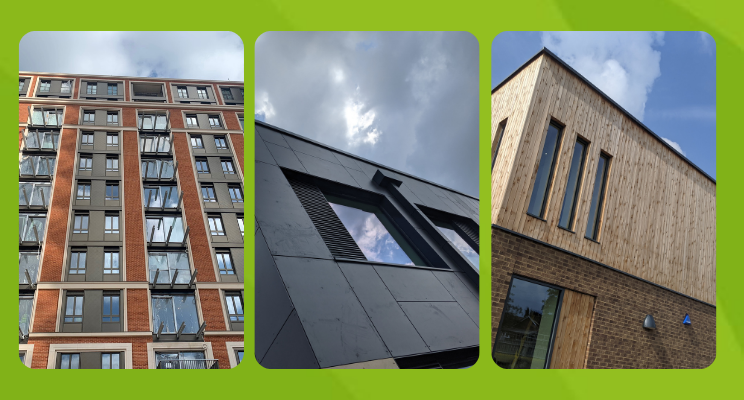As some of the UK’s largest construction companies are now beginning to reveal targets around carbon emissions, and to openly demonstrate their commitment to reducing their carbon impact, the focus on sustainable forms of building methods and materials has never been greater.
The environmental benefits of rainscreen cladding
If we are to meet the government’s goal of reaching net zero by 2050, as an industry we must make headway into reducing our emissions, and rainscreen cladding can offer significant advantages over other types of building materials in terms of environmental impact.
We’ve looked at some of the advantages of rainscreen cladding, and examples of projects we’ve completed where sustainable rainscreen cladding options have been specified.
1. Helping reduce the carbon footprint across a building’s whole life cycle
Cladding allows existing buildings to be adapted or repurposed, maximising the potential lifetime of a structure and reducing the need for demolition and rebuild. As the majority of the embodied carbon associated with new buildings is in the substructure and superstructure, cladding is an effective way to limit emissions.
2. Contribution to improved thermal performance
Rainscreen cladding is an effective way of improving the thermal performance of existing buildings, with the added advantage of no internal floor space being lost. A properly installed rainscreen cladding system can significantly reduce energy bills for the eventual occupants of the building, often a key consideration for investors and developers
3. Utilising low carbon materials
Many materials and combinations can be used for cladding, such as ceramic, aluminium, wood, or natural slate. Each material used with rainscreen cladding has its own benefits and, in many cases, can offer a greener alternative to traditional building materials.
In addition to these three important environmental factors, ensuring that a rainscreen cladding system is properly installed is vital. A poorly fitted system will not only underperform but is also likely to be costly and time consuming to remediate.
That’s why, when evaluating a potential sub-contractor, it is essential to review references and previous work, to ensure they can provide evidence of the scope and scale of work that has been completed.
Below we’ve outlined some examples of sustainable rainscreen cladding options, and some of the projects where we’ve installed them.
Timber cladding
Timber cladding is an increasingly popular choice for finishing the outside of commercial and domestic buildings. With a range of different products available including Western Red Cedar, Siberian Larch and Thermowood, timber should only be used from sustainable sources and for which certificates can be provided.
At the Willink School in Burghfield, we installed fire treated larch cladding using the Nvelope NV6 system. Larch cladding is a natural and sustainable option, that requires very little maintenance and will reduce the overall carbon footprint of a building.
Fibre cement cladding
Fibre cement cladding, created by mixing cellulose, fillers and fibres with water and cement, can be used as small tiles through to large panels. Providing a low maintenance, weather resistant solution, fibre cement can be through coloured or painted to achieve the desired aesthetic and requires little upkeep.
Fibre cement is lighter than other types of cladding and quick to install; our contractors have experience working with many different suppliers and are able to adapt to challenges often found on site.
At Addington Valley Academy in Croydon, our team installed Ceramapanel cladding panels. Made from fibre cement, Ceramapanel panels are cost effective, and their resistance to environmental impact means they are highly durable with little maintenance required.
Panels can be supplied pre-squared and finished off-site for efficient installation and are available in through coloured or painted finish.
Aluminium cladding
Aluminium cladding provides a durable, low-maintenance solution that will protect exterior walls from the elements. The lightweight material means the loadings on the underlying building structure are much less than masonry-based materials, whilst providing a low-cost method of improving the building’s thermal performance.
The project we completed at West End Gate in London for Berkeley Homes specified a patterned, hook-on cassette rainscreen cladding. Using solid aluminium panels, the challenge here was creating the diamond pattern to replicate shingles, whilst maintaining the strength in the panels.
With the government’s aim for 100% of all building processes to be operating at net zero by 2050, there are clear advantages to using rainscreen cladding for over cladding or recladding existing buildings, in addition to the sustainable and practical benefits of using rainscreen cladding for new building projects.
To find out more about our experience and projects where we’ve installed rainscreen cladding systems, get in touch on 01268 744199 or office@edenfacades.co.uk.

